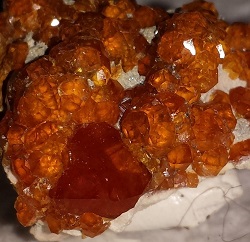A- |
B- |
C- |
D- |
E- |
F- |
G- |
H- |
I- |
J- |
K- |
L- |
M- |
N- |
O- |
P- |
Q- |
R- |
S- |
T- |
U- |
V- |
W- |
X- |
Y- |
Z |
SPESSARTINE:PHYSICAL CHARACTERISTICS:Color is orange, reddish brown, brown, pink and yellow. Luster is vitreous. Transparency crystals are transparent to translucent. Crystal System is isometric; 4/m bar 3 2/m Crystal Habits include the typical rhombic dodecahedron. But more commonly is found as the 24 sided trapezohedron. Combinations of these forms are common and sometimes the rare faces of the hexoctahedron, a 48 sided crystal habit that rarely is seen by itself, can also combine with these other forms making very attractive, complex and multifaceted crystals. Massive and granular occurrences are also seen. Cleavage is absent. Fracture is conchoidal. Hardness is 7 Specific Gravity is approximately 4.19 or less (above average for translucent minerals). Streak is white. Associated Minerals are feldspars, quartz, tourmalines, topaz, beryl, rhodonite and other manganese minerals. Other Characteristics: index of refraction is 1.80 Notable Occurrences are Pakistan; Madagascar; Brazil and Sri Lanka. Best Field Indicators are crystal habit, color, and hardness.
Spessartine, like other garnets, forms rounded crystals with 12 rhombic or 24 trapezoidal faces or combinations of these and some other forms. This crystal habit is classic for the garnet minerals. Spessartine is formed in manganese rich metamorphic environments and in some granitic pegmatites. Spessartine is somewhat rare but occasionally will accompany other minerals and make a nice accessory mineral to an outstanding mineral specimen. |

